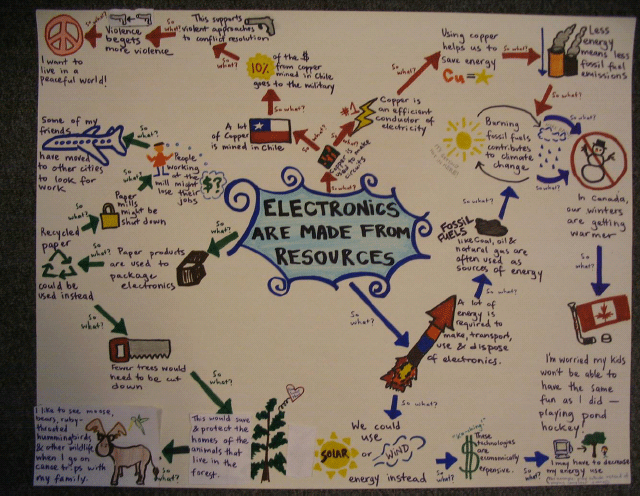Grade levels: 4 to 6.
Subjects: Art, Social Studies, Environmental Studies
Duration: 2 hours (can be reduced if students complete the so what? diagram as homework)
Description: Students create a so what? diagram in which they organize their personal reflection on the relationship between biodiversity and agriculture, and how it relates to things they care about.
Learning objectives: By the end of the activity, the students will be able to:
- Articulate the relationship between biodiversity and agriculture, and how it affects other things;
- Organize their ideas in a “So what?” poster.
Skills: Students will develop skills in the following areas:
- Poster presentation;
- Oral presentation;
- Developing a concept map.
Materials: drawing materials (paper, coloured pencils, crayons, old magazines).
Vocabulary: biodiversity, fair trade, sustainable agricultural production.
Procedure
- Sensitize students to biodiversity and agriculture issues (e.g. by working on other activities in this module).
- Start activity with a KWL chart or word wall to ensure students are familiar with appropriate vocabulary. (See appendix 1.)
- Have students read “So what?” in Biodiversity, food and farming for a healthy planet.
- Divide students into of three. In each group, assign a timekeeper, note-taker and reporter. Ask half the groups to come up with a list of good oral presentation techniques. Ask the other half to come up with a list of poor oral presentation techniques. The groups have five minutes to brainstorm ideas. After, the reporter in each group summarizes the group’s discussion for the rest of the class. The teacher may wish to post a list of good and poor presentation techniques in the classroom.
- Ask students to develop a personal response to one question, either “biodiversity is important for agriculture - so what?” or “agriculture affects biodiversity - so what?”. Student responses should take the form of a so what? diagram. Students can create their so what? diagram on paper (Bristol board works well) or, if they like working on the computer, they can create a flow chart using PowerPoint or similar software.
- Have students follow the steps for creating a so what? diagram:
- Write the phrase "biodiversity is important for agriculture" or “agriculture affects biodiversity” in a small box in the center of the large piece of paper.
- From the center box, draw a small line in any direction. Write the phrase ‘so what?’ on top of the line. Draw a second box at the end of the line. In the box, sketch your own personal answer to this question. For example, if a student selected agriculture affects biodiversity, they may write ‘forests in the Amazon are chopped down to create pastures for raising livestock’.
- From the second box, draw another line in any direction. Write ‘so what?’ on top of the second line. Draw a new, third box. In the third box, sketch a response to the previous answer. (E.g. the ‘so what?’ of forests in the Amazon are chopped down to create pastures for raising livestock could be, ‘deforestation is threatening the habitat of tropical rainforests and wild animals like monkeys and jaguars’.)
- Continue adding to this ‘line of thought’ until no more connections can be made. Then start a new line from the center box and repeat the process.
- Note: The lines of thought in the so what? diagram can be both positive and negative. For example, you may appreciate that we’re making an effort to curb greenhouse gas emissions but regret that you now have more work to do.
Some ground rules for your so what? diagrams: - Make it personal. This chart is about your own personal reaction to biodiversity and agriculture issues, not the ‘right’ reaction.
- Use pictures more than words (sketch pictures or cut and paste pictures from old magazines).
- Think big and broad. Think about all living things, near and far, now and in the future.
- The last box in each line of thought should be very personal - it should include an ‘I’ statement (e.g. I believe ...., I wish, .... I am ..., I would feel better if .... I like ....)
- Have each student present their so what? diagram to the rest of the class. Use the presentations as a starting point to discuss what concrete actions students can take.
- If using a KWL chart, have students complete the L column.
Assessment:
- Students present their so what? diagrams to the class.
- see appendices 3a, 3c and 3f for sample rubrics of participation and group work, oral presentations and concept maps.
Internet resources:
How to make a great poster
Other references: Activity based on “So-what?” activity of Teri Burgess, Learning For a Sustainable Future 2007.
Sample so what? diagram reflecting on the question “electronics are made from resources, so what?”.

Diagram courtesy of Natalie Gibb.